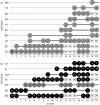Spread of arbitrary conventions among chimpanzees: a controlled experiment
- PMID: 17164200
- PMCID: PMC1702386
- DOI: 10.1098/rspb.2006.3733
Spread of arbitrary conventions among chimpanzees: a controlled experiment
Abstract
Wild chimpanzees (Pan troglodytes) have a rich cultural repertoire--traditions common in some communities are not present in others. The majority of reports describe functional, material traditions, such as tool use. Arbitrary conventions have received far less attention. In the same way that observations of material culture in wild apes led to experiments to confirm social transmission and identify underlying learning mechanisms, experiments investigating how arbitrary habits or conventions arise and spread within a group are also required. The few relevant experimental studies reported thus far have relied on cross-species (i.e. human-ape) interaction offering limited ecological validity, and no study has successfully generated a tradition not involving tool use in an established group. We seeded one of two rewarded alternative endpoints to a complex sequence of behaviour in each of two chimpanzee groups. Each sequence spread in the group in which it was seeded, with many individuals unambiguously adopting the sequence demonstrated by a group member. In one group, the alternative sequence was discovered by a low ranking female, but was not learned by others. Since the action-sequences lacked meaning before the experiment and had no logical connection with reward, chimpanzees must have extracted both the form and benefits of these sequences through observation of others.
Figures


References
-
- Bjorklund D.F, Yunger J.L, Bering J.M, Ragan P. The generalization of deferred imitation in encultured chimpanzees (Pan troglodytes) Anim. Cogn. 2002;5:49–58. - PubMed
-
- Boesch C. Three approaches for assessing chimpanzee culture. In: Russon A.E, Bard K.A, Parker S.T, editors. Reaching into thought: the minds of the great apes. Cambridge University Press; Cambridge, UK: 1996. pp. 404–429.
-
- Boesch C. Is culture a golden barrier between human and chimpanzee? Evol. Anthropol. 2003;12:82–91. doi:10.1002/evan.10106 - DOI
-
- Bonnie K.E, de Waal F.B.M. Affiliation promotes the transmission of a social custom: handclasp grooming among captive chimpanzees. Primates. 2006;47:27–34. doi:10.1007/s10329-005-0141-0 - DOI - PubMed
-
- Call J. Body imitation in an enculturated orangutan (Pongo pygmaeus) Cybern. Syst. 2001;32:97–119. doi:10.1080/019697201300001821 - DOI
Publication types
MeSH terms
Grants and funding
LinkOut - more resources
Full Text Sources
Research Materials
Miscellaneous
